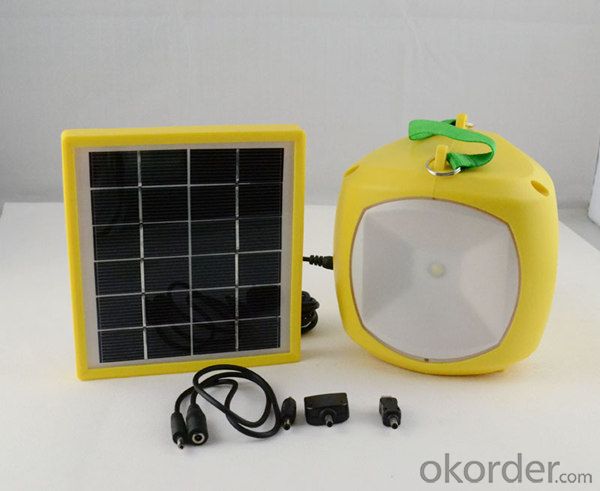solar camping lantern
- Loading Port:
- Guangzhou
- Payment Terms:
- TT OR LC
- Min Order Qty:
- -
- Supply Capability:
- 10000 unit/month
OKorder Service Pledge
Quality Product, Order Online Tracking, Timely Delivery
OKorder Financial Service
Credit Rating, Credit Services, Credit Purchasing
You Might Also Like



Main characteristics
1. Support two charging modes: Solar charging/ AC charging.
2. Convenient and easy to use durable with beautiful appearance.
3. 4 switches to adjust, high brightness/lower brightness/cell phone charger output/power off.
4. No wire, no installation, no hassle, fast and easy to install.
5. Green and energy saving and widely used.
Technical parameter
| Material | Transparent plastic PC/ABS |
| Solar Panel | Mono crystalline 1.5W |
| Battery | 6V/3500mAh |
| LED | 1W(1PCS) |
| Output | 5V/550mA |
| Charging Time | 10 hours charged by AC current, 22 hours charged by solar energy |
| Illumination Time | 10 hours for high brightness, 20 hours for lower brightness |
| Packing Measure | 175*140*155mm |
| Weight | 1.1KG |
| Accessories | AC Adapter/Cell phone charging cable with 3 different connectors |

- Q:Can solar energy systems be used in developing countries?
- Yes, solar energy systems can be used in developing countries. In fact, they can be particularly beneficial in these regions as they provide a sustainable and affordable source of electricity. Solar energy systems require minimal infrastructure and can be easily implemented in remote areas without access to the traditional power grid. Additionally, solar energy can help reduce reliance on fossil fuels, improve energy security, and promote economic development in developing countries.
- Q:Can solar panels be installed on carports or parking structures?
- Yes, solar panels can be installed on carports or parking structures. In fact, it is a popular choice as it allows for efficient use of space and provides shade for cars while generating clean energy.
- Q:How do solar energy systems impact the grid?
- Solar energy systems impact the grid by injecting clean and renewable energy into the system, reducing the overall demand for fossil fuel-based electricity. This helps to decrease greenhouse gas emissions and promote a more sustainable and environmentally friendly energy sector. However, solar energy systems also present challenges for grid operators due to their intermittent nature, as they only produce electricity when the sun is shining. Grid integration and management strategies are required to balance the variations in solar energy generation and ensure grid stability and reliability.
- Q:How do solar energy systems contribute to reducing greenhouse gas emissions?
- Solar energy systems contribute to reducing greenhouse gas emissions in several ways. Firstly, solar power is a renewable energy source that does not release any harmful greenhouse gases during its operation. By replacing fossil fuel-based electricity generation, solar energy systems significantly decrease the amount of carbon dioxide and other greenhouse gases emitted into the atmosphere. Secondly, solar energy can be used for heating and cooling purposes, reducing the reliance on fossil fuel-powered systems that contribute to greenhouse gas emissions. Lastly, the widespread adoption of solar energy systems encourages a shift towards a more sustainable and environmentally friendly energy mix, leading to long-term reductions in greenhouse gas emissions.
- Q:How do solar energy systems reduce carbon emissions?
- Solar energy systems reduce carbon emissions by converting sunlight into electricity without producing any greenhouse gas emissions. This renewable energy source replaces the need for fossil fuels, such as coal or natural gas, which release carbon dioxide and other harmful pollutants when burned for power generation. By harnessing the power of the sun, solar energy systems significantly contribute to reducing greenhouse gas emissions and combating climate change.
- Q:Can solar energy systems be used in powering agricultural irrigation systems?
- Certainly, agricultural irrigation systems can be powered by solar energy systems. As a matter of fact, solar energy is gaining popularity in the agricultural industry due to its numerous advantages. To begin with, solar energy is a clean and renewable source of power, which aids in reducing greenhouse gas emissions and combating climate change. This is especially crucial in agriculture, where conventional power sources like diesel generators contribute to air pollution. Furthermore, solar energy systems are simple to install and maintain. They typically consist of solar panels, an inverter, and a battery storage system. These components can be installed on rooftops, open fields, or even on solar trackers to maximize exposure to sunlight. Once installed, solar energy systems require minimal upkeep, resulting in reduced operational expenses for farmers. Moreover, solar energy systems are particularly well-suited for powering agricultural irrigation systems. Irrigation systems often require a constant and dependable energy source to pump water from wells, rivers, or reservoirs to the fields. Solar energy can fulfill this need for consistent power supply, particularly in sunny regions with high irrigation demands. Additionally, solar energy systems can be combined with energy storage solutions like batteries. This enables farmers to store surplus energy generated during the day and utilize it during periods of low sunlight or at night, ensuring uninterrupted power supply for irrigation systems. Furthermore, solar-powered irrigation systems can prove to be more cost-effective in the long run. Although the initial investment for installing solar panels and associated equipment may be higher compared to traditional power sources, the operating costs are significantly lower. Once the solar energy system is in place, farmers can benefit from free energy from the sun, reducing reliance on expensive fossil fuels or grid electricity. To sum up, solar energy systems are a feasible and sustainable choice for powering agricultural irrigation systems. They offer environmental advantages, are easy to install and maintain, and can provide a reliable and cost-effective energy supply for farmers.
- Q:Can solar energy systems be used for powering off-grid sustainable communities?
- Yes, solar energy systems can be used to power off-grid sustainable communities. Solar panels can generate electricity from sunlight, which can be stored in batteries for later use. This renewable energy source is clean, abundant, and can be harnessed in remote areas where grid access is limited. By relying on solar power, off-grid sustainable communities can reduce their reliance on fossil fuels, lower their carbon footprint, and achieve long-term energy independence.
- Q:Can solar energy systems be used in areas with high levels of noise pollution?
- Yes, solar energy systems can be used in areas with high levels of noise pollution. Solar panels do not produce any noise themselves as they convert sunlight into electricity. Therefore, noise pollution does not affect the functioning or efficiency of solar energy systems.
- Q:Can solar energy systems be used to power large industrial facilities?
- Yes, solar energy systems can be used to power large industrial facilities. Advances in solar technology have made it possible to generate electricity on a large scale through solar panels or concentrated solar power systems. These systems can provide a significant amount of power required by industrial facilities, reducing their reliance on traditional energy sources and minimizing their carbon footprint.
- Q:Can solar energy systems be used in powering amusement parks?
- Yes, solar energy systems can definitely be used in powering amusement parks. Solar power has become increasingly popular in recent years due to its numerous benefits. Amusement parks require a significant amount of energy to operate rides, lighting, and other facilities. By utilizing solar energy systems, parks can reduce their reliance on traditional energy sources and significantly lower their operational costs. Solar panels can be installed on rooftops, parking lots, or open areas within the amusement park to harness the power of the sun. These panels convert sunlight into electricity, which can be used directly to power various park operations. Additionally, excess energy generated during peak sunlight hours can be stored in batteries for use during cloudy or nighttime periods. The advantages of using solar energy in amusement parks are manifold. Firstly, it is a renewable and sustainable energy source, meaning it does not deplete natural resources or produce harmful emissions. This makes solar energy an environmentally friendly choice, aligning with the growing emphasis on green initiatives and reducing carbon footprints. Furthermore, solar energy systems can provide a stable and predictable source of power. Amusement parks often experience high peak energy demands during busy periods, such as weekends or holidays. Solar panels can easily handle these fluctuations and ensure a reliable power supply, reducing the risk of power outages or disruptions. Moreover, installing solar panels can enhance the overall image and brand of an amusement park. By demonstrating a commitment to sustainable practices, parks can attract environmentally conscious visitors and differentiate themselves from competitors. This can contribute to a positive public image and potentially increase visitor numbers. In conclusion, solar energy systems can undoubtedly be used to power amusement parks. Their ability to generate clean, reliable, and cost-effective electricity makes them an ideal solution for powering the energy-intensive operations of amusement parks. By harnessing the power of the sun, parks can reduce their carbon footprint, lower operational costs, and enhance their overall appeal to visitors.
1. Manufacturer Overview |
|
|---|---|
| Location | |
| Year Established | |
| Annual Output Value | |
| Main Markets | |
| Company Certifications | |
2. Manufacturer Certificates |
|
|---|---|
| a) Certification Name | |
| Range | |
| Reference | |
| Validity Period | |
3. Manufacturer Capability |
|
|---|---|
| a)Trade Capacity | |
| Nearest Port | |
| Export Percentage | |
| No.of Employees in Trade Department | |
| Language Spoken: | |
| b)Factory Information | |
| Factory Size: | |
| No. of Production Lines | |
| Contract Manufacturing | |
| Product Price Range | |
Send your message to us
solar camping lantern
- Loading Port:
- Guangzhou
- Payment Terms:
- TT OR LC
- Min Order Qty:
- -
- Supply Capability:
- 10000 unit/month
OKorder Service Pledge
Quality Product, Order Online Tracking, Timely Delivery
OKorder Financial Service
Credit Rating, Credit Services, Credit Purchasing
Similar products
New products
Hot products
Related keywords




























